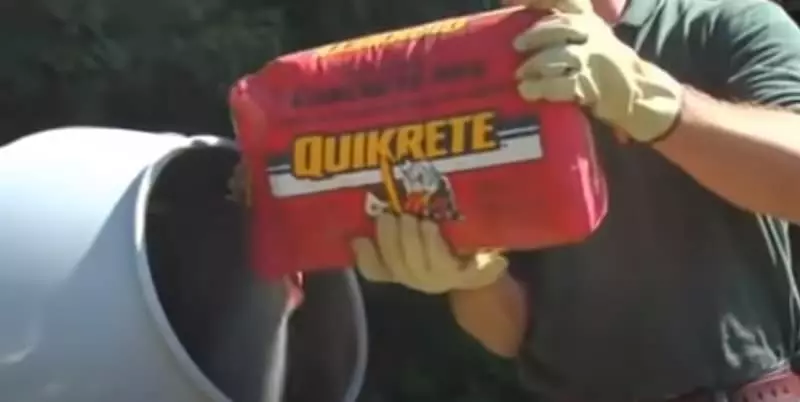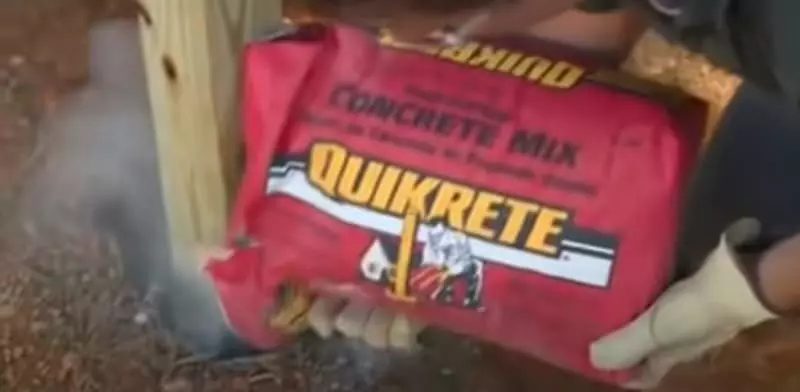Rapid-setting concrete is easy to set and dries fast. It’s also durable, reaching 4000 pounds of force for every square inch ( after a month). This type of concrete is stronger than that used for foundations on most houses. It is also beneficial for many jobs both inside and outside your property.
You don’t need fast-setting concrete for fence posts as it isn’t the drying speed of the posts that matters but how straight they are. Standard concrete might be more cost-effective for a large-scale project. However, fast-setting concrete is an excellent option for a small project, and the cost may not seem all that much.
It’s essential to factor in the scale of your DIY project before deciding which type of concrete to use. This article will outline the tools you need for the job and help you factor in the cost of using fast-drying cement. Let’s also discuss the differences between concrete and cement.

Table of Contents
How To Set Your Fence Posts In Concrete
Before endeavoring to set your posts in concrete, you must ensure that you have all the right tools for your project. Having the right tools to hand makes the job easier and enables you to finish your work to the highest standards. Consider the following tools you will need:
- Insulated fences graft
- Post concrete
- Point crowbars and chisel
- Level
- Fencing tamper
Insulated Fencers Graft
This tool is occasionally referred to as a fencing spade, and it makes digging holes much easier.
This spade features a long and durable handle that eliminates the need for bending while digging, making it more comfortable for your back. In addition, the insulated handle protects you against serious injury if you accidentally hit an energy source.
Post Concrete
Fast-setting concrete is a mixture of cement and ballast, and you can apply this mix to timber, metal, and concrete fence posts.
Rapid concrete is ideal for small jobs around your garden. Apply your cement by first filling the post hole about 1/3 deep with water, then pouring the concrete evenly around the post until you cannot see the water.
Point Crowbars And Chisel
Point crowbars and a chisel are essential when installing posts on tough terrain. These tools can also reach tight spaces that fencer grafts cannot.
Level
When installing fence posts, a level is one of the most vital tools to have at hand. A level ensures that every post is straight.
Fencing Tamper
If you prefer not to use concrete, fencing tampers allow you to secure your posts into position using the original soil. Fence posts have round heads for ramming soil into post holes. This tool can operate in tight spaces due to its vertical design.
What Is The Best Concrete Mix For Fence Posts?
The best concrete for fence posts is a fast-setting mix, for example, Quikrete, which offers several advantages over traditional concrete mixes:
- Fast-setting: Fast-setting concrete doesn’t need to be mixed in a bucket or a wheelbarrow. You pour the dry concrete from the bag right into the hole and add water. This allows you to quickly move on to the project’s next stage or backfill the hole to finish the job.
- Easy to work with: Fast-setting concrete mixes, such as Quikrete Fast Setting Concrete Mix, are designed to be easy to work with. They require minimal effort and expertise, making them suitable for DIY projects.
- Quick curing time: Under normal curing conditions, you can apply heavy weight to the post after just four hours. This is a great convenience when setting fence posts, as it allows you to proceed with the installation without waiting for the concrete to cure fully.
- Strength: Look for a fast-setting concrete mix with a high psi (pounds per square inch) rating, such as 4000 psi. This ensures that the concrete will provide a strong and durable foundation for your fence posts.
- Availability: Fast-setting concrete mixes like Quikrete Fast Setting Concrete Mix and SAKRETE Fence Post Mix are readily available at home improvement stores like Home Depot.
Quikrete is easy to work with, doesn’t require mixing, and sets up quickly. All you do is pour it directly into the hole and soak it with water.
When considering the type of concrete you need for your particular job, you must base your decision on the soil type, weather, season, fence post, and project specifications.
For small and medium-sized jobs, premixed bags are best. However, a concrete truck could be too costly for a small project, and mixing by hand is too arduous and time-consuming.
Quikrete fast-setting concrete is pretty convenient, and there is no need to mix it. You just pour it into the hole along with the water.
The concrete will harden and be fully set just by getting it wet. You don’t need any trowels, trays, or tools – it’s that straightforward.
The concrete should harden within twenty to forty minutes but will take twenty-eight days to completely cure to 4000 psi. Since you don’t need to mix this concrete, there is no risk of creating a weak mix by over-watering.
A 50 lb bag of fast-drying will work for about three posts. Generally, it costs about $15 per fence post. The convenience of fast-drying concrete comes at a cost, as it usually costs about a dollar more than standard concrete.
If you are building a privacy fence that needs sixty bags of concrete mix, and the rapid-setting concrete costs one dollar more than the regular stuff. This means that you could make a saving of $60 with the standard concrete.
Can I Use Regular Quikrete For Posts?

You can use regular Quikrete for posts if time isn’t an issue. However, you can save even more money by purchasing cement and aggregate (gravel, sand, and rock) and using your cement mixer. A cement mixer ensures that the mix is consistent.
It can be challenging keeping galvanized metal or wood aligned as your concrete sets – this is why more people gravitate towards the fast-drying Quikrete. Standard concrete sets in about a day or two.
There is a tendency to use more water when mixing your concrete to make it easier to pour and complete. However, the more water you add to the mixture, the weaker it makes the concrete. Follow the brands’ instructions for the correct balance.
How Long Does Concrete Take To Set In A Post Hole?
Fast-setting concrete mix can take about twenty to forty minutes to set, and you can apply some weight to your posts after four hours.
However, it is best practice to wait twenty-four hours before proceeding with fence construction. Regular concrete mixes can take about two hours to set and cure for 24 to 48 hours before applying any force to your posts.
Curing times rely on temperature as temperatures over 90 degrees can lead to evaporation. This cuts short the curing process, resulting in weakened concrete and cracking.
On the other hand, temperatures lower than 40 degrees Fahrenheit delay curing significantly. Temperatures below 25 degrees Fahrenheit freeze the concrete, resulting in a loss of 50% of the concrete’s strength.
How Do I Keep My Post Level While The Concrete Dries?
You need two braces per post, and each one must be at least four feet long. You can attach those braces by tapping 1-by-2-inch stakes into the ground with a sledgehammer.
When you measure them from the center of the hole, they should be 90 degrees from each other.
Attach each brace to a stake with one screw before setting the post. This allows the end of the brace-free to pivot along with the wooden post, stabilizing it; so it’s ready to use.
Before setting your post, keep it slightly longer so you can cut it to the correct height. Next, fill the bottom of the post hole with gravel. This helps the water drain. Drop in your post and use it to tamp down the gravel, then adjust the faces in the correct directions.
You must level your post in two directions using a 4-foot level. After straightening it in the first direction, place one of the braces against your post, and insert a single screw to attach the brace to the post.
Then level and brace the post going the other direction and start filling the hole.
To set a good level fence, posts must be arrow-straight, as wood tends to warp and twist slightly.
Pressure-treated wood is an excellent option, but you must select the straightest posts you can find to prevent running into problems. However, the bottom of the pressure-treated posts can rot if you just set them in concrete.
To prevent your posts from rotting, set them on top of coarse gravel about 3 to 6 inches deep. Concrete should be poured around the wooden post – not under the post.
This allows moisture trapped between the concrete and the bottom of the post to drain away through the gravel, away from the post.
Should I Use Concrete Or Cement For Fence Post Holes?
Concrete and cement are often used interchangeably. However, cement is an ingredient of concrete. Concrete is a combination of paste and aggregates; aggregates are gravel, sand, or crushed stone. The paste is a mixture of water and cement.
By volume, cement contains 10 to 15 percent of the concrete mix. Cement and water harden and bind the aggregates into a rock-like mass through the hydration process. This process continues for many years so that concrete strengthens with age.
Concrete is the best material for setting wooden fence posts, especially if you have sandy soil. Gravel might work with clay-heavy, dense soil, as concrete doesn’t have the necessary drainage and can trap moisture, resulting in the wood rotting.
But, generally speaking, concrete is the best option for looser soil, and it will keep your fence posts firmly in place.
Final Thoughts
You can use fast-setting concrete for setting fence posts. Although, if you want to keep costs down, regular concrete is also an excellent option.
Whether you use fast-drying or ordinary concrete, wear a long-sleeved shirt, proper eye protection, water-proof gloves, and a long-sleeved shirt. Wash any mixtures from your skin straight away. Rinse your eyes with clean water instantly after contact and seek medical attention straight away.
Recent Posts
Fences are important for keeping our homes safe. They help in preventing the entry of unwanted intruders and thus keeping our house secure. There are different types of fences available in the market...
If you are looking for privacy, then you will get that with vinyl fencing. They come in different styles, colors, heights, and prices making them budget-friendly.